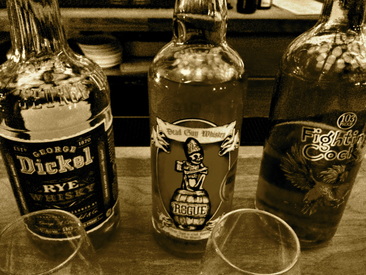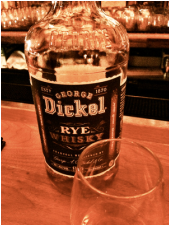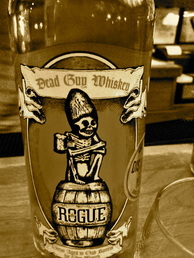 When I stepped into the whiskey bar, a row of men were seated at the counter. An hour later, they were replaced by a row of women. I liked the change. They also brought some great conversation with them. Overheard: “A whole year! I thought I was 29 and I was 28. Maybe this year, I will be 28 for the whole year instead of 29.” Amen to that. Unless your age is 10, 12, 15, or 18 and stamped on the side of a Scotch bottle, how much does it really matter? My other companions at the bar were a pretty motley crew. There was George Dickel, a rye but charcoal mellowed, a process made famous by Tennessee whiskey (although this rye is from Indiana), Dead Guy Whiskey out of Oregon, and Fighting Cock bourbon from Kentucky.  George Dickel What I knew: 90 proof, 95 percent rye, and 5 years old What I learned: This had a sweeter smell than a typical rye, no doubt thanks to the charcoal mellowing. That’s when the whiskey if filtered through charcoal before being put in a barrel. Tends to take out some of those sharper notes. It was spicier on the tongue than on the nose, but still light with a sweet edge. I know the bottle claims that they “let our whiskey rest as long as it needs to,” but I felt like this one came off as tasting a little bit young. It has a good flavor, but kind of faint. I would have liked it stronger. Just as the flavor was really sinking in, it started to melt away.  Dead Guy Whiskey What I knew: Distilled in Oregon from the sweet wart of Dead Guy Ale, ocean-aged in oak barrels for one month What I learned: Although not based in Portland, it’s very Portland. It’s not enough to make the whiskey from a local beer. They also have to age it out on the ocean in a barrel. The distillery is named Rogue. Indeed. Whiskey is booming in Oregon, not surprising with the whole microbrewery history there. I’ve had a couple of really yummy whiskies from out that way – Temperance and McCarthy’s come to mind. This one was really its own thing, though. From what I learned, yeast is added to the sweet wort from beer, ferments for seven days, gets double-distilled in a copper whiskey still, and then heads out to the ocean to age in a barrel for a month. It’s not very hoppy, though. So as compared to other “beer whiskies” I’ve tried, this one was less beer. That didn’t make it more whiskey – it wasn’t really one or the other. Lighter than a whiskey, but sweeter than a beer, it’s probably the one whiskey I really wanted cold. It was pretty laid-back and chill. I could drink this at a barbeque or maybe on an Oregon beach, sitting on the driftwood under the perpetual cloud glaze.  Fighting Cock What I knew: Bourbon, aged 6 years, 103 proof What I learned: Whew! Stronger than the others, for sure, with that sweet bourbon smell. It tasted very familiar, but not like the wheat whiskies I’m used to from Heaven Hill. You can definitely taste the strength in the proof. It’s fuller and richer, but still easy drinking. And not overpoweringly sweet. A little drip of water just opens it up, so it fills the mouth and drips down the sides. Brings out a little spice and wood, and really brings out the heat. If I could choose a candy flavor for Willie Wonka to develop next, it would probably be this one.
0 Comments
Your comment will be posted after it is approved.
Leave a Reply. |
Archives
November 2017
|

 RSS Feed
RSS Feed
